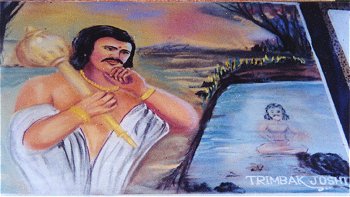Kannada Poet Ranna (990CE- 1060 CE)
by Dr. Jyotsna Kamat
First Online: April 15, 2012
Page Last Updated: December 07, 2024
Kavichakravarti (emperor among poets) was the
title conferred on Ranna by his patron Chalukyan emperor Satyashraya
Irivabedanga who ruled Karnataka from 998 CE to 1008 CE. Ranna is among
the three gems of Kannada literature -- two others being Pampa and
Ponna who are considered greatest among old Kannada poets. All the
three belonged to the present day North Karnataka region. The powerful
[(Chalukyas)] and [(Rashtrakutas)], who ruled a vast empire, were also
great patrons of poets, philosophers and leaders of different faiths.
Ranna has eulogized his patron comparing him to Bhima, One of the heroes
of Mahabharata. In fact, he is the greatest, according to Ranna in
munificence, valor, magnanimity and other virtues!
Ranna belonged to Vaishya community and caste of bangle-sellers. His is
a unique case of outstanding merit getting all encouragement in olden
times, irrespective of caste and creed. A Jaina by faith, Ranna's three
works are Gadayuddha and Ajitanatha Purana, life and achievements of
Jaina thirthankara and Ranna kanda a short dictionary or glossary. Two
more works ascribed to him are not forthcoming. He had the rare
opportunity of getting patronage from Chavundarya who is responsible
for the great monolithic statue of Gomateswara at Shravanabelgola as
also Attimabbe the saintly donor who encouraged both poets Ponna and
Ranna in no smaller way.
Ranna hailed from Muduvolal (present day Mudhol in Bagalkot District).
His father was Jinavallabha and mother was Abbalabbe. He had two wives,
Jakki and Shanti, a son Raya and a daughter Attiimabbe. Ranna seems to
have mastered Sanskrit besides Kannada and had deep knowledge of several
branches of learning then known.
Ranna has chosen only the last phase of Mahabharata war, the combat of
maces between Bhima and Duryodhana, ending in the latter's
death. He has adopted flashback or "Leo-look technique" wherein by-gone
events are narrated or presented as flashes as in radio plays or films.
By any standards it is a modern way of presentation for his tenth
century milieu.
Ranna has obliquely referred to mediocrity in the field of literature of
his times. Poets with born talent do not enrich it with vast reading or
intent listening. Hence their works lack pep and remain wordy burden.
Some good poets receive only bad or indifferent comments from the
critics. Patrons at time turn stingy, which makes poets (writers in
general) very hard to make out a living. If only people were more
generous, and literary community less envious, poets could be better
off, Ranna felt.
The rivalry of Bhima and Duryodhana is the subject of Ranna's important work
K.L. Kamat/Kamat's Potpourri
Bhima Finds Duryodhana Hidden in Lake
Rangoli Painting by Trimbak Joshi
Fight with maces (gade or gada) must have been a popular combat
in Ranna's times as well. It required immense strength, sustenance as also
nimbleness with the very heavy maces. He gives a list of footwork, postures and
norms for such deadly games. Nobody could hit below the belt. Only chest,
shoulder, back and neck were aimed at. One was also not expected to kill the
enemy when he collapsed or became unconscious. When Bhima fell, Duryodhana the
villain did not hit but kept his mace whirling in the air, which had fan like
effect which helped Bhima revive! But it is Bhima who hits hard on the thighs of
Duryodhana, the most susceptible part of the latter's body after getting a clue
from Lord Krishna who was watching the combat and wanted to help Bhima.
With a single episode of mace-duel, Poet Ranna has brought out the entire
panorama of Mahabharata. It throws light on innumerable vignettes of man's quest
for superiority, eternal values of humility, patience, magnanimity and
perseverance. The Language is powerful, style vigorous and lively. He is
courteous enough to acknowledge the greatness of poets Pampa and Ponna who
preceded him, by stating that merit cannot be envied (gunakke machcharamunte?).
Gadayuddha also provides an insight of ancient genius. Poets of those times were
compelled to write within the strictly laid down norms. Over ages, Indian poets
had to borrow themes from the epics or life of gods and goddesses as subject.
But it is surprising how they have taken full liberty to depict contemporary
heroes and incidents in their own vision. Ranna has excelled in bringing out
noble traits of Duryodhana, villain of the piece.
We do not have Ranna's portrait. However his signature in stone is preserved for
posterity on the foot of Gommateswara statue erected by his patron Chavundaraya

See Also:
-
History of Kannada Language -- Jyotsna Kamat on the origins, development and important periods in the Kannada literature.
